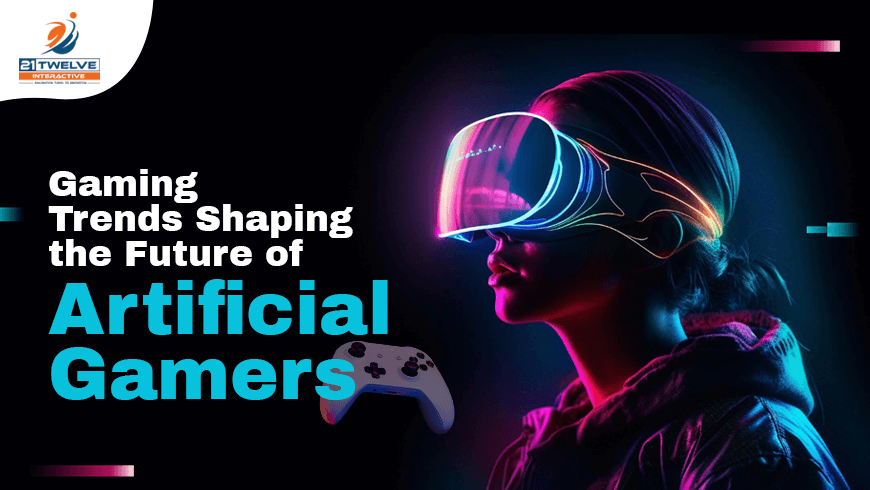
The gaming world undergoes constant transformation, with each passing year introducing captivating trends and innovations that capture the imagination of both developers and players. In 2024, the landscape of gaming development stands on the edge of groundbreaking advancements.
The dynamic nature of the gaming industry ensures a continuous evolution, and the upcoming year promises to be no exception. Developers and gaming enthusiasts can anticipate unprecedented progress and novel experiences as the ever-evolving world of gaming takes another significant leap forward.
Table of Contents
In upcoming years, game development trends are balanced to unfold, shaping the future of interactive entertainment on the gaming stage. Here are the top 5 Trends that will shape the future of Artificial Gamers in 2024 which are listed below:
Why is the Gaming Industry growing?
The gaming industry is experiencing rapid growth due to several key factors. Firstly, technological advancements have elevated gaming experiences with high-quality graphics, immersive virtual reality, and responsive gameplay.
The widespread availability of smartphones and affordable gaming consoles has expanded the gaming audience globally. Additionally, the rise of online multiplayer games and competitive esports has created a vibrant community, fostering sustained engagement. Streaming platforms have given rise to gaming influencers, further boosting the industry’s visibility.
Moreover, the increasing integration of gaming elements into various sectors, such as education and healthcare, demonstrates the versatility and broadening appeal of gaming. These combined factors contribute to the dynamic growth of the gaming industry, making it a powerhouse in the entertainment landscape.
Importance of Understanding Gaming Trends for Developers and Players
Understanding gaming trends holds paramount significance for both developers and players, shaping the landscape of the gaming industry. For developers, staying abreast of emerging trends is crucial for creating relevant and engaging content.
It provides insights into player preferences, technological advancements, and market demands, enabling developers to tailor their creations to meet evolving expectations. Moreover, Game Development Trends empowers developers to anticipate the next big thing, fostering innovation and maintaining a competitive edge.
On the player’s side, understanding gaming trends enhances the overall gaming experience. Being aware of trends also enables players to make informed choices about the games they invest time and money in, ensuring a more satisfying and enjoyable gaming journey.
In essence, the symbiotic relationship between understanding gaming trends and the player experience is integral to the continued growth and dynamism of the gaming industry.
#1: Hyper-realistic Graphics and Immersive Environments
Gaming realism will significantly increase by 2024 due to incredible breakthroughs in artificial intelligence (AI) and graphics technology. The ultimate manifestation of this transformation is exemplified by extraordinarily realistic images meticulously produced by cutting-edge GPUs and AI algorithms.
These innovations closely mimic real-world events while surpassing conventional boundaries. The line between reality and the virtual world is blurred by AI-driven visuals, which capture the finer details of character expressions and the complex interactions between light and shadow.
Moreover, this effect is amplified by AI-enhanced immersive settings, giving players an unmatched sensation of presence and engagement. The 3D game development creates a visually spectacular and incredibly engaging gaming experience that pushes virtual realism to new heights.
#2: AI-Driven Procedural Content Generation
The incorporation of artificial intelligence (AI) is causing a revolutionary change in the gaming environment of 2024 with procedural content production. With its ability to create game content dynamically, player preferences, and behavior, AI algorithms are taking this practice to previously unheard-of levels.
Because AI skillfully creates levels, challenges, and even story aspects on the fly, every game becomes unique and customized. This innovative methodology yields a gaming universe that is ever-evolving and boundless.
In such cases, Game Development Trend helps to add new components to keep players interested and happily surprised. It provides them with a dynamic and constantly changing world that fosters a deep sense of exploration and discovery.
#3: Enhanced Personalization through Player Behavior Analysis
In the gaming world in 2024, artificial intelligence (AI) will be at the forefront of providing individualized gaming experiences with a fundamental understanding of player behavior. Cutting-edge algorithms analyze player actions, preferences, and decisions in real-time to enable game developers to customize experiences for each player precisely.
This degree of detail goes beyond simple personalization and includes dynamic changes like in-game item recommendations and difficulty adjustments based on the player’s skill level.
Game Development Trends like Artificial intelligence (AI)-powered personalization create a deep and distinctive bond between players and the game, increasing immersion and enjoyment. This innovative approach ensures consumers have entertaining, individually relevant, and meaningful gaming experiences.
#4: The Rise of Competitive AI in Multiplayer Games
Artificial intelligence (AI) transcends its traditional confines within single-player experiences, emerging as a formidable force within multiplayer games. Competitive AI takes center stage, introducing unprecedented challenges to human players.
In this era, AI opponents cease to be static entities and dynamically adapt and learn from the strategies employed by human counterparts, creating an ever-evolving challenge. It not only injects a fresh layer of excitement into multiplayer gaming but also revolutionizes the landscape of cooperative play.
The seamless collaboration between human players and AI teammates becomes a reality, unlocking new possibilities. They work in tandem to achieve shared objectives, reshaping the dynamics of multiplayer gaming in previously unimagined ways.
#5: AI-driven Storytelling and Dynamic Narratives
In 2024, the game industry is witnessing a drastic shift in video game storytelling, going beyond conventional pre-written narratives. To tell dynamic and engaging stories, game development with advanced technology is becoming increasingly important.
AI systems create stories that dynamically adjust to each player’s path by carefully examining their decisions, deeds, and interactions. When players see their choices impacting the story as it develops, this degree of dynamic storytelling fosters a strong sense of agency.
AI-driven storytelling is revolutionizing player engagement and game world-shaping, whether through emergent narratives or branching stories. It ushers in a new era where every player’s experience becomes personalized and intrinsically meaningful.
Challenges and Ethical Considerations
The gaming industry faces a variety of complex issues and moral dilemmas that require close examination. Concerns over exploitative tactics have been brought up by loot boxes and microtransactions, which have sparked a discussion about their effects on player welfare and the potential for addiction.
The industry is also criticized for its lack of diversity and representation in game design, which reinforces prejudices and silences underrepresented voices. The popularity of internet gaming also raises other problems, such as toxic gaming communities and cyberbullying and harassment.
Furthermore, concerns concerning the blurring of boundaries between reality and the virtual world are raised by the ethical implications of AR VR Gaming technology. To overcome these obstacles, industry players must work together to provide an inclusive, player-centered, and responsibly innovative gaming environment.
Future Implications and Opportunities
The future of the gaming industry holds vast implications and exciting opportunities. With advancements in technology, the rise of AR VR Gaming technology promises immersive gaming experiences that transcend traditional boundaries.
Cloud gaming services are poised to democratize access, allowing players to enjoy high-quality games without needing powerful hardware. The integration of artificial intelligence (AI) enhances gameplay through personalized experiences and dynamic narratives. Esports provide global access to competitive gaming and present affluent prospects for sponsors and participants, which are growing exponentially.
As gaming increasingly intersects with education, health, and social interactions, the industry stands on the edge of a transformative era where innovation and collaboration will shape a diverse landscape of entertainment, education, and social connectivity.
Conclusion
As mentioned above, the gaming business will undergo a dramatic transformation in 2024 due to the revolutionary force of artificial intelligence. These revolutionary developments not only raise the standard for gaming to an unprecedented level but also create new avenues for exploration.
The world of artificial gamers is revealed to be an exciting new frontier that piques the curiosity of both players and developers. This mutually beneficial link between creativity and technology offers a fascinating voyage into unexplored lands, influencing games in ways that were before unimaginable.



